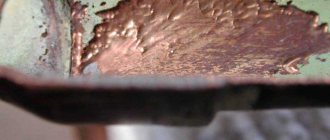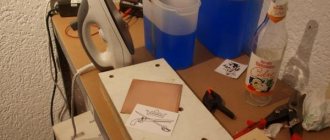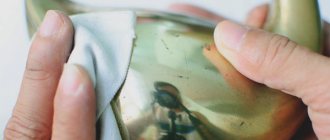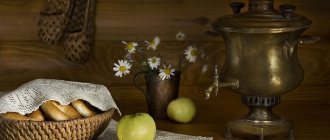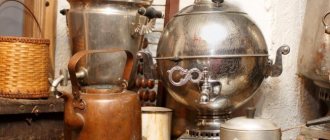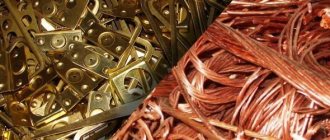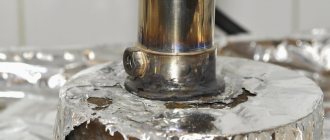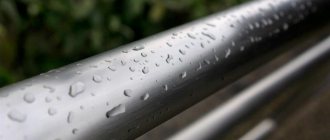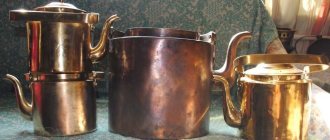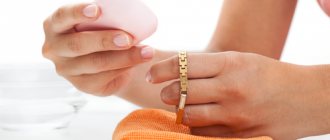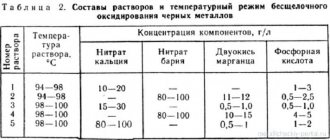How to clean copper oxide at home
Ketchup Dishwashing detergent Lemon juice “Vinegar dough” Bath of vinegar and salt Water and citric acid Paste based on chalk and ammonia Sulfamic acid A solution of oxalic acid, turpentine, citric acid and ethyl alcohol
How to clean copper coins yourself
9% vinegar 10% citric acid Ammonia or ammonium carbonate solution Ammonia
Copper products began to be produced back in the 4th-3rd millennium BC. The golden-pink colored metal was easier to mine than gold, silver and iron. At the same time, copper was then equal in value to precious metals. Copper received its Latin name - cuprum - in honor of the island of Cyprus. It was there that the richest copper deposits were located.
Source: Unsplash (@thecupandtheroad)
Before the development of technology, this metal was used only in the production of jewelry and added to other alloys, after which they began to make dishes and interior items from copper, because, unlike their iron counterparts, vases, plates, teapots and anything else made of copper are resistant to corrosion. Plus, copper also has disinfecting properties. For example, in Ayurveda (Indian traditional medicine), copper has been used since ancient times to sterilize water.
In general, copper products have many advantages, but in order for them to be useful and delight you with their pinkish glow, you need to clean them properly. Otherwise, oxidized copper utensils may become harmful to health.
Useful tips and tricks
It is worth adhering to the following recommendations to maintain the shine of copper products for a long time:
- To preserve the natural copper shine of objects for a long time, you can use a protective varnish coating. For example, cheap copper jewelry can be coated with clear nail polish. This method allows you to isolate the product from contact with the air atmosphere and human skin, which will preserve its shine for a long time. Besides nail polish, you can also use beeswax. This product can be found in relevant stores.
- Do not use abrasives or steel objects when cleaning copper metal as they are harder than soft copper and can severely scratch the product.
- Heat and humidity are the enemies of copper cookware, as they significantly accelerate their destruction and blackening. To avoid continued exposure to these factors, store the product under appropriate conditions, such as a dry, ventilated cabinet.
- It is not recommended to cook food containing a lot of acids in copper cookware at high temperatures. Products containing acids, such as vinegar, fruits, tomatoes and others, cause serious harm to copper products.
- Most decorative items are coated with a protective varnish layer. Such items should be washed only with warm water and soap and do not use abrasive materials or polish these items, as all this can damage the protective coating. In addition, products with a protective coating require special care, so it is recommended to follow the manufacturer's instructions.
- Some copper food utensils have a protective coating that must be removed before using the utensils for their intended purpose. There are two ways to remove the coating: place the product in boiling water with a small amount of baking soda, or thoroughly wipe the product with a cotton cloth soaked in alcohol or acetone, and then rinse under running water.
- Do not forget to wipe copper products with a damp, clean cloth, not allowing dust and dirt to accumulate on them.
Home methods for cleaning black on copper products should be used from time to time as needed, but you need to understand that the items will become thinner each time.
How to tidy up a samovar?
A classic copper samovar can look very elegant and attractive. But only on condition that it is completely clean. Meanwhile, a dark film inevitably forms on the copper surface; it is created by contact with oxygen. A faulty device, which is only suitable for decorative purposes, needs to be filled with boiling water. If the samovar can still work, pour cold water into it and bring to a boil.
In the arsenal of a modern housewife, there are many different ways to maintain copper products in an attractive condition. The following methods are considered the most effective and common:
- Take a metal container that will hold the copper item. Fill it with water, add a little of any detergent or cleaning product. Using a soft cloth or sponge, remove light dirt from the metal surface. Then immerse the product in clean water to rinse off any remaining detergent.
- Freshly squeezed lemon juice works well even on old stains. Cut the lemon in half, rub it on the copper item, leave for a few minutes, and then rinse under running water.
- Tomato paste or ketchup are also good options for cleaning copper at home
. To carry out this procedure, squeeze the required amount of ketchup or paste into a container and lower the product into it. The copper item should be left in this product for 10 minutes and rinsed with warm water. After this treatment, the metal will look like new. - If your favorite copper piece has dark stains, try removing them with a vinegar solution. Fill a saucepan with water, dilute vinegar and salt in it. For 1 liter of water you will need 3 tbsp. l. vinegar and the same amount of salt. Dip the dish you are going to clean into the prepared solution, put the pan on the fire and bring the water to a boil, boil for 10 minutes and rinse with warm water.
- Pastes based on chalk and ammonia also cope well with dirt. To prepare this cleaning product, you need to prepare a 25% ammonia solution, ground chalk and water. Mix these three components in a ratio of 5: 2: 10. Treat contaminated copper items with the prepared paste and leave them for 10-15 minutes. Then thoroughly scrub the entire surface of the metal with a brush with medium-hard bristles. Rinse the product under running water and wipe dry with a soft cloth.
Cleaning copper cookware
To safely clean products, all these methods can be used only after a preliminary test of the metal’s reaction to the cleaning agent. Testing is carried out in a small area; if no changes have occurred, the entire product can be cleaned.
Often plaques of various origins form on copper utensils. There are several options for cleaning copper at home
to remove any plaque that has formed. They are presented in the table below.
| Plaque color | Product used | Cleaning method |
| Yellow color (formed when copper comes into contact with lead) | Acetic acid 9% | Place the product completely in acetic acid, after 15 minutes rinse with warm running water and wipe dry with a soft cloth. |
| Red color | 5% ammonia solution | The item is placed in the solution for 10 minutes, after which it is rinsed with water. |
| Black plaque | Ammonia | Moisten a soft cloth with ammonia and treat the entire surface of the metal. After cleaning the metal, wipe it with a clean cloth. |
| White plaque | Sulfamic acid | Using a sponge, carefully apply sulfamic acid to the entire surface of the product, and after 10 minutes, rinse it off with water. Be sure to use rubber gloves when handling this harsh chemical. |
| Green plaque | Oxalic acid, ethyl alcohol, turpentine Citric acid | All components must be taken in equal proportions, mixed and carefully treat the metal surface with a sponge. At the end of the procedure, rinse the product under water. Bright green plaque can be removed with citric acid. It must be diluted with water 1:2, treated with product, and washed off after 10 minutes. |
Features of cleaning copper products
Any copper object, even if it just sits at home and is not used in any way, gradually darkens and even becomes cloudy. A variety of things are made from copper and its alloys - dishes and coins, figurines and decorative jewelry, electronic components and radio components, jewelry and much more. It follows that there simply cannot be a single approach to pollution.
At home, almost anything can be cleaned with regular detergent.
Just put the item in a container filled with hot water and add the drug there, put a sponge or soft cloth. Using this sponge, gently scrub the product, then transfer it to another previously prepared container filled with clean water. This simple treatment will remove most mild stains.
Tomato ketchup will also help to wash copper items relatively easily. It is squeezed into a deep bowl, where the dirty item is placed. After ten minutes, you can rinse it thoroughly, and the cleaning is complete. A dark stain can be easily removed by immersing the item in a weak solution of acetic acid (60 grams of table salt is added to it for greater effect). The container must be metal, because it will need to be boiled on a gas stove for at least 10 minutes.
This treatment will convert the oxides into a soluble form. Wait until the removed item has cooled down, then soak it in clean cold water for a while, then wipe it dry with a soft cloth. Any of these methods can be used only after you have tested the effect of the products on a small part of the product.
Coins
A ten percent solution of vinegar in water can quickly remove yellow plaque. When the dirt is gone, the mixture must be carefully drained and the coins rinsed in warm water. Until they are washed, it is not recommended to handle them with unprotected hands! The red layer is removed with ammonia 5% - sometimes you have to keep the copper circles in it for several hours, otherwise the original appearance cannot be restored. As always, after cleaning with any composition, rinsing in water is mandatory.
Greenish deposits are often found on coins. Pour citric acid into a glass of water 1/10 full, and then add clean water to the top. Then they carefully place coins in the glass and monitor the reaction. As soon as all the liquid acquires a green tint, the products are removed, thoroughly washed and slightly polished.
Sometimes washing coins is quite simple - put them in warm soapy water and let it sit for a while, wipe with a sponge and dry on a clean cloth. Cleaning copper coins with abrasives, potent drugs, concentrated acids and alkalis is unacceptable. Do not try to remove dirt by exposure to high temperatures.
, this may lead to the product melting or losing its strength.
Valuables
If you need to tidy up a bracelet or antique item, you need to take special care. Bright green deposits are removed with a ten percent citric acid solution
Before cleaning, always inspect all stains and the product itself, and carefully choose a method to solve the problem. If you don’t have ammonia on hand, prepare a combination of 5 milliliters of turpentine and alcohol, one milliliter of water and one gram of oxalic acid. Shake the preparation thoroughly, use a sponge to lubricate the faded item with it, and after 5-10 minutes remove the rest of the mixture with a dry cloth.
If copper utensils are not completely free of green deposits, it is absolutely unacceptable to cook food in them!
If the item is large and you do not have a container where you can put it, you need to thoroughly scrub the surface with half a lemon, then with a soft brush, and then rinse.
Small items
A combination of lemon juice and salt can easily clean a copper cross or other small item. Squeeze the juice from the fruit into a bowl (deep plate), the consistency of the mixture should be like porridge. Take a portion of the product with a soft cloth and thoroughly wipe the item until the dirt disappears. Don't forget to rinse and dry the product after cleaning! If you really don’t have time, just add ketchup to a plate and leave the dirty item in it for an hour.
If a copper tap is installed in your house, tomato paste will help restore it to its original cleanliness. Apply it to the surface and leave for about 30 minutes, then rinse and wipe dry.
How to clean copper products until they shine?
The choice of cleaning method depends on the degree of contamination and the type of product that needs to be treated.
White spots on copper are also formed due to oxidative reactions. They usually appear on products made from alloys of copper and other metals. One of the presented methods will help against this kind of contamination: using ammonia, vinegar with salt or ketchup.
How to clean copper from black and green deposits?
Ammonia can deal with black and green deposits. You can also remove the toxic layer with a mixture of turpentine, oxalic acid and vodka. The ingredients are mixed in equal proportions and the copper products are cleaned with it using a cloth.
Cleaning copper from rust
To renew rusty copper products, use aggressive acids such as hydrochloric acid. Apply acid to a piece of cloth and treat the copper with it. After treatment, rinse thoroughly to remove any remaining aggressive substance.
How to clean copper oxide?
To remove oxide in the form of a reddish coating, place the product in a 5% ammonia solution or ammonium carbonate. Hold until the plaque begins to come off.
How to clean a copper pot inside and outside?
The outer surface of the Turk can be cleaned using any of the methods presented above.
If you do not have experience working with aggressive chemicals and acids, use accessible and safe methods.
On the inside of the Turks, it is recommended to use softer substances so as not to damage the coating. For example, soda or ketchup.
Mechanical cleaning of copper products
Over time, a layer of dirt adheres to jewelry and various objects with carved patterns, consisting of many parts. You can get rid of it mechanically.
Start by removing surface dirt by washing the jewelry with soapy water. Next, use a needle to remove dirt from small holes and crevices. Then go over the entire product with a toothbrush.
During mechanical cleaning, you can use salt or baking soda, so the effect will be achieved faster.
How to clean tinned copper?
During the tinning process, a thin layer of tin is applied to the inside of copper cookware.
Tin is a soft metal and must be cleaned with care.
Do not use sharp objects or harsh abrasives.
To clean a tinned copper product, you need to wash it with dishwashing detergent. Severe dirt is removed point by point with a soft brush or fine steel wool, previously soaked in vegetable oil.
How to clean a copper samovar?
The copper samovar is an antique
Therefore, it is especially important to preserve its appearance and extend the service life of an antique device
To clean a copper samovar, take salt, vinegar and flour in equal proportions. The ingredients are mixed and applied with a sponge to the outside of the samovar.
After treating the entire surface, remove any remaining cleaning agent with a dry cotton cloth. To make the surface shiny, wipe it with lemon.
How can you clean a brass samovar?
Brass is an alloy of copper and zinc. Aggressive chemicals and abrasives can damage the surface of such a samovar.
For safe cleaning, use oxalic acid. It must be diluted in 1 liter of water, applied to the surface of the samovar and left for 5 minutes for the reaction to occur.
Afterwards, the solution is washed off and the surface is wiped with a sponge soaked in soda solution to neutralize the acid. Rinse the product and wipe dry.
Clean a copper basin at home
As a rule, a copper basin is used to make jam. Such dishes have good thermal conductivity, antiseptic properties, are safe for humans, and when cooking the jam practically does not stick to the walls.
If the jam is still burnt, the copper basin can be cleaned with vinegar dough. For this ancient method, you need to knead the dough by mixing flour and table vinegar. Next, the dough is rolled out thinly and placed on the dirt.
After the mixture dries, carefully remove it. The vinegar paste absorbs dirt, making the surface perfectly clean.
Basic methods for cleaning copper products
Let's start looking at how to clean a copper coin at home. For items made of copper and other metals, specialized liquids are produced that successfully remove dirt, oxides, and uneven patina from the surface. Due to their high cost, not everyone will purchase these solutions, because there are other methods for high-quality cleaning of samovars, coins, dishes and other products. These means of restoring the original appearance of objects include:
- water-soap solution;
- lemon acid;
- Vaseline oil;
- "Coca Cola";
- soda solution.
Soap and water solution
Before cleaning copper coins at home, prepare a soap solution. Shavings of ordinary laundry soap are dissolved with hot water (1 to 8), poured into a basin or other metal container. Coins are placed in this jelly-like solution and kept for ten days. Periodically it is necessary to heat the container with water, without bringing it to a boil. Gradually, dirt and blackness will begin to disappear from the surface, after which you just need to wipe the items with a cloth. To speed up the removal of oxide and dirt, you can use a soft-bristled toothbrush.
Lemon acid
How to clean copper at home easily and quickly? If there is a thick film of uneven oxide with a green tint on copper objects, citric acid is used. To do this, take seven parts of plain water to three parts of acid. To clear the greens from a coin, place it in the solution for 10 minutes. As a result of a chemical reaction, the product will be cleaned and all dirt will float to the surface. This may cause a pinkish tint that will disappear after a few weeks. At the end of the procedure, the copper object is washed with soapy water, which contains alkali. This is necessary to stop the acid from affecting the metal. In case of severe oxidation, the procedure may be repeated.
Vaseline oil
Small specimens can be cleaned with oil. Vaseline is most suitable for this purpose. Before cleaning an antique copper coin, place a container of oil on the tile. To clean a coin, place it in a boiling oil liquid over low heat. In this way, you can quickly get rid of stains, rust and oxides on a collectible item. The oil has a very high boiling point, which speeds up the procedure. At the end of the process, the item is washed with ethyl alcohol.
"Coca Cola"
Children's favorite drink can rid the surface of copper items of greenery, as well as other contaminants. To do this, coins are placed in a small container and filled with sweet fizzy drink. It is advisable to use glass containers. After a few days, all dirt and oxides will be successfully cleaned and things will acquire an attractive appearance. This effect occurs due to the presence of orthophosphoric acid in the effervescent drink. It is this that helps clean the metal from oxidizing greens and other contaminants. To speed up the process, you can place the container on a warm radiator or use another source of constant heating. This is the most original way for those interested in how to clean copper at home.
Soda solution
You can use soda solutions on low-quality old objects that have good resistance to destruction. Before cleaning copper coins at home, add baking soda (2 tbsp) to a bowl and add plain water (5 tbsp). The resulting consistency after mixing should look like a slurry. This mass is applied to the surface of the product with small rubbing movements. Processing time will depend on the degree of contamination of the items and may take several weeks. You can speed up the procedure with additional brushing with a toothbrush. After the process is completed, the items are washed with running water and dried.
After cleaning your items at home, you need to dry them properly. For these purposes, paper towels are suitable, which should be folded in several layers and covered with them on both sides of the product. It is recommended to use only soft towels to avoid damaging an antique item or coin. Drying can be carried out using a drying cabinet heated to 100 °C. To slow down oxidative processes, the product is periodically wiped with crumpled black and white newspaper. Everyone has to choose how to clean copper items at home individually.
Organic oil
Collectors use petroleum jelly or glycerin, but really anything will do: highly purified vegetable oil, cosmetic oil, or Johnson's Baby oil.
- Pour oil into a container and place a coin in it.
- Wait a week or two.
- Clean the copper with a scraper.
In this way you will remove minor plaque and darkening.
If soaking gives poor results, boil the coins in oil. This method is effective for cleaning well-preserved but dirty items. If you boil a heavily damaged coin, you will dissolve not only the plaque, but also the top layer of copper along with the coinage.
The coin is dipped into boiling oil for 5-7 minutes. During this time, the plaque turns into a sticky dense mass. Remove it with a brush and soapy water.
Soon you will have black but pure copper in your hands. Advice. The vapors from the oil are very flammable. During boiling, the container with oil must be covered with a lid.
Handy products for cleaning copper products
If necessary, you can clean a fairly large piece of home decor from green deposits - rub its entire surface with half a lemon, since its large size will not allow it to be placed in any container. Afterwards you need to wait a while, about five minutes, and rub the surface with a brush, and then rinse with water.
This method is excellent for cleaning copper chandeliers, lamps, and plumbing fixtures at home, because this way you can easily and simply get rid of traces of oxidation on the surface of products.
If it is necessary to clean copper utensils from any contamination, then you should be aware that copper that has turned green or gray can be quite toxic and therefore you should not eat food from such utensils. After all, this can cause serious harm to health. So if the dishes are still covered with a green coating, then it is better to leave them as a piece of home decor.
But before that you will have to clean it. To do this, you just need to place such dishes in hot water with baking soda added to the detergent, then you need to rub it, and then rinse it in clean water. This method will help you quickly and efficiently clean copper products without much time and effort.
If the required copper item is too dirty, you can clean it by placing it in a solution of vinegar with the addition of a small amount of salt and bringing this solution to a boil. After the product has cooled, you need to wipe it and rinse it with warm water, this way you can quickly clean the copper.
To clean polished copper products, you just need to moisten the surface in kerosene and then wipe it with chalk powder using a woolen rag. The cost of kerosene is about 30-50 rubles per liter, so this cleaning can be not only quite effective, but also economical.
You can also wipe a copper object with an ammonia solution (ammonia) and then rinse it thoroughly under running water; this method will effectively help remove green deposits and blackness.
Digestion
Cooking significantly speeds up the cleaning process. Typically a soda solution is used:
- Mix 1 tsp. soda and 100 ml of water.
- Bring the solution with the objects immersed in it to a boil.
- Hold the coins for about 5 minutes, then remove them with tweezers and evaluate the result. To do this, soak a piece of rag with vegetable oil and wipe the surface with it.
- If it doesn’t work the first time, you need to return the samples to the boiling solution and try again.
Advice: Practice on inexpensive items first, and then start cleaning more valuable ones.
How to return noble patina to copper
Many methods of cleaning coins, along with oxides and dirt, also remove the natural patina, which is so highly valued by numismatists. In order to artificially recreate it, you will need sulfur ointment. It can be purchased at a pharmacy.
The left side has patina, the right side is cleared of it.
Sequencing:
- pour warm water into a small basin or bowl;
- put on rubber gloves;
- apply and rub sulfur ointment into the coin, this should be done with your hands under water;
- try to distribute the ointment evenly over the product;
- as soon as the metal begins to darken, the product must be removed and wiped with a paper towel;
- leave the coin for two days to consolidate the effect;
- After that, lubricate with Vaseline and polish with a felt cloth.
The desired effect is achieved in several doses, with an interval of two months. It should be remembered that artificial patina is easily washed off with a product containing acid.
Cleaning rust
In addition to plaque of various shades, rust appears in the top layer of copper objects, which is iron oxides in the form of flakes. To remove it, use strong acidic solutions, and to wash products, use a baking soda solution.
An acid solution is poured into a cup made of ceramic, glass or other inert material and the copper product is immersed in it with tweezers. A reaction will begin, during which rust is removed and dark smoke comes out. When the process is complete, the product is carefully removed and placed in a baking soda solution to neutralize the acid. The washed item is thoroughly wiped with a rag.
Important! When handling acid, be sure to protect your hands with rubber gloves, wear a protective mask or goggles and a respirator.
Why you need to clean regularly
The need for constant cleaning of copper objects arises due to the fact that a dark coating and oxide film quickly appears on the surface. Products that are heated or used in open air conditions oxidize especially quickly. Frequent use of products made of metal causes tarnishing and blackening. The external condition of jewelry made from this metal depends on external factors with which it interacts regularly.
Copper utensils, if not cleaned, begin to release harmful toxic elements. In this case, you cannot use kitchen utensils for cooking. If you cannot wash the dishes using all available methods, it is better not to use them for their intended purpose in order to avoid negative consequences.
Reasons for the raid
Dishes, furniture fittings, jewelry and other things made of copper need periodic cleaning to remove green deposits. This need is associated with the characteristics of the metal. Due to prolonged exposure to air or exposure to temperature, such things become covered with a dark greenish film. Oxides are especially noticeable on dishes that are constantly used in the kitchen. Darkening can only be removed by cleaning.
Jewelry with copper behaves differently. They sometimes darken, but then return to their original state. It is widely believed that this behavior of the metal is a reflection of the health of the owner of the jewelry. In reality, such changes only reflect a reaction to environmental indicators: fluctuations in humidity, pressure or temperature.
Important! Oxides on copper cookware are especially dangerous. If plates and pots are not cleaned for a long time, the metal releases toxic substances that are harmful to human health.
Metal oxidation
Copper in its usual state has a reddish tint. If a metal is exposed to air for a long time, it acquires a red-violet or blackish tint due to a layer of oxides forming on its surface. Prolonged exposure to high humidity conditions provokes the formation of a layer of hydroxides on a copper product. Then a greenish color appears. An acetic acid layer of blue-green color also appears on the copper from contact with vinegar. It is a poisonous substance.
Cleaning coins with soap
Soap is a fairly mild cleaning agent that is practically incapable of killing a coin. We need to make a soap slurry. To do this, we are looking for a bar of soap that contains EDTA (ethylenediaminetetraacetic acid). This is our cleaning agent, which will rid the coin of oxides and dirt. We grate the soap or chop it with a knife, dump it into an unnecessary container and fill it with warm water to make a porridge. Stir until a homogeneous consistency and throw in coins, previously washed under the tap with a brush.
The time during which coins will be cleaned depends on the amount and nature of the oxides. For example, you can wait a month, or two, or even six months. It is better to take out the coins once a week and rub them under running water with a toothbrush with cut bristles.
As I wrote above, the disadvantage of this method is the long cleaning time. Soap has almost no effect on the metal of a coin. but if you overexpose the coin, the patina may come off, since it is also an oxide. In theory, when you arrive from the cops, you can immediately throw the coins into a bowl of soap.
By the way, I highly recommend covering the whole thing with a lid so that the soap does not dry out and lose its activity. I will also say that if the coin’s relief is supported solely by oxides, later only a bald round piece will come out of the mess. If such specimens are of any value, it is better to clean them mechanically.
Paste GOI
This method is used by newbie collectors. GOI paste removes blackness from metal and makes it bright and shiny. The paste does not remove serious oxides or calcium deposits.
But experienced numismatists do not approve of the use of this tool. GOI paste is soft but abrasive. During processing, you will remove light dirt, but damage the protruding elements of the coin: the edge and the design. The more you try, the more actively you remove dirt, the more you smooth out the chasing.
At the end you will get a shiny coin with “licked” small details. This is not a problem when you are cleaning your silverware. But for collectible coins this result is unacceptable.
The exception is when you need to remove a small stain on the smooth part of the coins. In this case, dip a cotton swab into the paste and carefully wipe the problem area with the tip.
